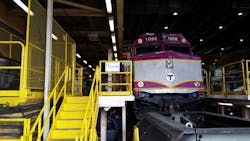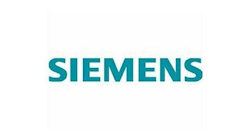Talking to employees that run the commuter rail in Boston, Massachusetts, there’s one thing that inadvertently comes up in nearly every conversation: the winter of 2015.
Touring the control room at Boston’s South Station on a Keolis Press Trip, Keolis Commuter Services Director of Train Operations Rich Murhpy said, “We’ve had blizzards in the past. But the winter of 2015 cannot be explained if you weren’t there. It was nothing like we’ve ever seen.”
Four days after our meeting, it would be 29 years working on the railroad for Murphy. In that control room, formerly a dark, cavernous room with old projectors to see the screens and handwritten information being documented on paper, Murphy spent his first 15 years with Amtrak, which shares the space with Massachusetts Bay Transportation Authority’s commuter rail, operated and maintained by Keolis Commuter Services. He then worked for the commuter railroad.
“This is our third railroad [Keolis Commuter Services]. We change but stay the same,” he said, “because the railroad is the railroad.” Though, as he explained the dynamics of the control room, the technology, ridership and aging infrastructure change the challenges.
A little over two years ago, the room was renovated with new LED screens displaying the network via an ARINC system, and large, open windows offering views of the skyline and of the South Station tracks. There’s a dispatcher that runs the terminal in and out of South Station, the Amtrak dispatchers control the Amtrak mainline and where the trains break off on the commuter rail lines is where the Keolis dispatchers take over for the commuter rail system. “Even though we’re two different companies, we’re still a team,” said Murphy. “We’ve all worked together forever.”
Snowmageddon
The January 2015 northeaster created snow emergencies in six states and there were travel bans in four of those, including Massachusetts. Nearly 9 feet of snow fell in Worcester, Massachusetts, making it the city’s largest storm accumulation on record.
“I’m not talking drifts,” Murphy stressed. “I’m talking 9 feet. There was no getting out of that.
“In the old-school mentality — and I was part of that — we’re here to run the trains, so we run trains.” He continued, “The problem was, we had snowstorm after snowstorm and they weren’t 6-inch snowstorms. A foot, 2 feet, every three or four days.”
Leslie Aun, vice president of corporate communications, Keolis North America, said, “It was really a very challenging time but in some ways, it helped make possible some of the things we’re able to do today because it really forced a lot of attention on what a lot of the system’s issues were. I’m not sure where we’d be where we are today.”
An Evolution of Service
Changes in communication, new service plans and a closer look at the operations came out of the storm and have created dramatic changes for the passengers.
Keolis Commuter services Customer Service Manager Linda Dillon said prior to that winter, the commuter rail schedule was what it was; it changed every spring and every fall. One of the innovations out of 2015 was a timetable of a snow schedule. The fall/winter schedule comes out November 13 with four levels of operation. Throughout the winter, MBTA and Keolis monitor weather forecasts to determine changes in the schedule of the commuter rail service.
Dillon said, “If there’s a big storm, we automatically go … to blue schedule. Everywhere with blue [on the timetable] means that train won’t run.”
Prior to this, trains either ran or they didn’t run. Now, they work together to determine the best way to handle service, protect equipment and keep passengers aware.
“Our passengers’ biggest concern,” Keolis Customer Services Customer Communications Manager Andrea Ruggiero said, was, “Where’s my train?” The timetable gives passengers the information in advance, to know which trains won’t run during weather disruptions.
Housed with the call center team and closely connected to the dispatchers, Keolis added a team of customer service staff dedicated to responding to passengers on Twitter to let people actively know what’s going on with their trains. “We live by our Twitter,” Ruggiero stressed. The team is trained in all parts of the railroad as they track all of the different departments, she explained. “They’ve gotten to know a lot about the railroad,” she explained. “To do the service alerts, you’ve got to know track construction and configurations, signals, control points, all those things. They’ve learned a lot.”
Maintaining the Fleet
The commuter rail service has 40 new locomotives and then about 50 more from the 80s. Some of those older locomotives that were never overhauled, are part of a Unit Exchange Program, UTEX. This maintenance overhaul has been put in place to get old, out-of-service locomotives back in service.
“It’s been important to us for several reasons,” explained Keolis Commuter Services Chief Mechanical Officer Ernest Piper. “It’s getting more locomotives into the mix, so that gives us more flexibility for the customer.
“From a business standpoint, it’s showing that we can do work here in-house, because there aren’t a lot of facilities in New England.”
While the locomotives should have had an overhaul at 10 years, they didn’t. And with a cost of a new locomotive being about $5.6 million, Piper said this is coming in at about one-fifth that cost. “We’re building a bridge for six to eight years while the T gets some breathing room to say, ‘OK, what is the next big investment we make in equipment?’" said Piper. “They’re going to be able to make a more structured decision instead of being forced into it. That’s the strategy behind the UTEX program.”
In the past five years, the MBTA has bought 40 new locomotives built by Motive Power in partnership with General Electric. “They’ve had some growing pains,” Piper said, ”but they really were the first fast-loading, fast-accelerating diesel locomotives I’ve ever seen.
“When you’re running diesel like this … they take a long time to load due to the nature of what they are.” He continued, “What the MPI locomotives do, they make that conversion really quickly so they accelerate really quickly.
“Siemens is building the Charger locomotive and that’s the next one that is going to try and crack that market because there are so many other places that are going into that.”
When Piper came on board, there was no production line in the maintenance department and it was staffed around a 5-day operation. He said it’s been a gradual transition to get things where they are today.
One of the big things they’ve been doing over the last year in particular, is getting everybody used to the "7-day railroad" as he called it. Staffed at a 5-day operation, he said it lacked continuity, as all the weekend work was overtime. Piper said, “People will say, ‘Happy Friday,’ and I always say, there is no weekend on the railroad.”
He spoke about the shift in the way they do their PM work, as well. “It should be a line that moves right along; you know what happens at every stage in the line. We were getting further and further behind because … we have to do 85 to 88 maintenance events a month to stay even.
“There are so many locations around Europe where Keolis has been doing this in their sleep, and to be able to bring some of those … well-established principles of mechanical maintenance to this facility and the operation? That’s a big deal.”
He said of the transition, “It’s foolish to try and transform it all overnight because it’s too much for the system to take because you’re not dealing with a lot of robotic stuff here. It’s people.
“They have to readjust their view of what’s in the yard of possible.” He stressed, “It’s fun, because you’re seeing the transformation.”
Contracting for Growth
On June 30th, an operating amendment with the MBTA was signed that incentivizes Keolis Commuter Services to grow revenue and grow ridership.
“It first started when some of our international colleagues were coming here … taking a step back, looking at our network, recognizing how open the commuter rail system was here,” explained David Mitrou, general counsel, vice president client & commercial affairs with Keolis Commuter Services. “No fare gates at the major stations in Boston or the outlying points, the transactions on board were cash-based, those features … don’t reflect the innovations that are taking place elsewhere in the world.”
A conversation with the MBTA evolved, looking at how Keolis could improve revenue protection and also, what it could do to drive ridership. A marketing revenue team was created as the first step — the first time that marketing has been a part of the scope of the commuter operator.
“We think there’s a lot of opportunity to drive that ridership and figure out places where the system’s underutilized,” said Mitrou. “Even the name itself suggests it’s ‘to and from work,’ but we know there’s a lot of opportunity.
“With the right amount of data collection and analysis that we can convert into creative ideas that are used elsewhere in the world, we can bring that here.”
There is currently an enhanced fare protection program, which was started after Labor Day — the Fare is Fair campaign. Keolis deployed about 30 ticket verification agents out in the network at key stations doing ticket checks. The idea behind that activity is to start changing people’s behavior, to get them used to the concept of verifying a ticket prior to boarding.
The next step will be to introduce temporary gates at the North Station, South Station and Back Bay Station — the three main Boston stations. The temporary gates will be configured in a way they anticipate utilizing the permanent fare gates. With the temporary gates, there will also still be ticket agent staff.
This type of contract and partnership demonstrates the interest between the operator, the city and the agency to grow the market, said Clément Michel, president & CEO of Keolis North America. “There’s really untapped potentials for growing the market.
“I’m really glad after 18 months of negotiations, to have this contract,” he said. “Now, we really have common interests with the MBTA in growing ridership.
“I’ve seen some places where … you have rogue operators, they’re trying to cut costs as much as possible and not trying to grow their workforce, they’re minimizing their costs."
Keolis Commuter Services CEO and General Manager David Scorey explained that part of the revenue partnership is exploring how they can make the last mile of the journey easier for passengers. “It’s enabling passengers to connect every step of their journey that really suits them.
“If you make it easier, more accessible, it encourages ridership. It overcomes some of the constraints,” he said.
“Employing technology, looking at rideshare schemes, maybe hooking up with other transport providers … We’ve been very successful elsewhere in the world. We can bring that technology and thinking — how to connect the dots — bring that to the operation here.”





